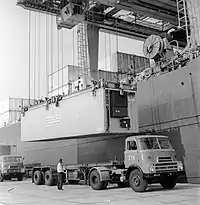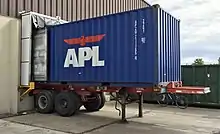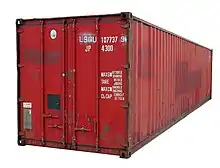Container chassis
A container chassis, also called intermodal chassis or skeletal trailer, is a type of semi-trailer designed to securely carry an intermodal container. Chassis are used by truckers to deliver containers between ports, railyards, container depots, and shipper facilities,[1]: 2–3 and are thus a key part of the intermodal supply chain.

Operation
The use of chassis to haul containers over-the-road is known as drayage trucking, and represents the roadway section of intermodal, which also includes rail transport using well or flat cars and overseas transport in ships or barges. Lifting a container onto a chassis is performed by a crane and must ensure that the container's corner castings line up with the chassis’ twistlocks (pins). The container is locked to the chassis by twisting the pins.[2] The length of a chassis determines which container it can accept (e.g., a 40-foot-long chassis only fits a 40-foot-long container), however some models are adjustable length.[3]


Semi-tractor trucks can hook up to chassis via the kingpin. When disconnected from a tractor, the chassis' landing gear can be cranked down to park it.[4]
Portable generators, also called gensets, can be mounted (underslung) onto chassis. These gensets are used to power a refrigerated container.[5]
In the US, some chassis, especially 20-foot and 53-foot chassis, have sliding tandems. The tandems are pulled back for heavy containers to comply with federal bridge law weight restrictions.
An identification number is usually stenciled on chassis to keep track of each unit in a fleet. According to ISO 6346, a chassis should have the letter "Z" at the end of its reporting mark. For example, ABCZ-123456 7 would mean the equipment is a chassis, specifically, number 1234567 in the fleet of company ABC.

A variation is the tank container chassis, which are used for portable bulk liquid containers or ISO tank containers. They are characteristically longer and have lower deck height then standard chassis, ideal for transporting constantly shifting payloads. These chassis can also be fitted with additional accessories including: lift kits to facilitate product discharge, hose tubes, and hi/lo kits to carry two empty tanks. The tank chassis has evolved over the years to accommodate greater payload weights. They come in tandem axle, spread axle, tri-axle, and hi/lo combo configurations.
.jpg.webp)
Chassis Pools

Unlike other countries where chassis are mostly owned or long-term leased by trucking companies, in the United States most chassis are currently owned by a few leasing companies (pools) which rent out the equipment to truckers.[1]: 1 [6] When a trucker leaves or enters a facility with a pool chassis, an EDI record is generated at the facility gate which identifies the trucking company and the chassis pool, and this allows the pool to invoice the appropriate trucking company for chassis usage. The steamship lines influence this system by offering a service called ″carrier haulage″ or ″store door delivery″, whereby they arrange the drayage of a customer’s container. The steamship line hires a local trucking company and pays the pool for the chassis usage. In order for a steamship line to lock in chassis prices for this ″carrier haulage″ service, they often contract with a particular chassis pool and require the truckers they hire to use that pool.[7]: 26 [8][9] Some disadvantages of this system are that it can restrict truckers' choice of which chassis to use[10] (especially at facilities where containers are mounted onto chassis before the trucker arrives to pickup[11]) and it can cause "chassis splits", which are when a container and its required chassis pool are in different locations.
Shortages
In the United States, container chassis shortages are a chronic problem, especially during peaks in container volume.[12] There are several causes of chassis shortages, but a common problem is excessive off-terminal dwell time. Off-terminal dwell time is the length of time a shipper keeps a chassis/container at their premises. Long dwell times mean less free chassis on-site at ports and rail ramps.[13][14]

See also
References
- National Academies of Sciences, Engineering, and Medicine. (2012). Guidebook for Assessing Evolving International Container Chassis Supply Models. Washington, DC: National Academies Press. doi:10.17226/22682. ISBN 978-0-309-25863-0.
{{cite book}}: CS1 maint: multiple names: authors list (link) - Hildebrand, Michael; Noll, Gregory; Hand, William (2018). Intermodal Container Emergencies (2nd ed.). Burlington, MA: Jones & Bartlett Learning. p. 69.
- Muller, Gerhardt (1989). Intermodal Freight Transportation. Eno Foundation for Transportation. p. 113.
- "Containerisation International Year Book". Containerisation International Year Book. London: National Magazine Company. 1971. Retrieved December 22, 2020.
- Filina-Dawidowicz, L.; Santos, T.; Guedes Soares, C. (2016). "Refrigerated cargo handling: Demand and requirements for Portuguese ports". In Guedes Soares, C.; Santos, T. (eds.). Maritime Technology and Engineering 3. Vol. 1. Leiden, The Netherlands: CRC Press. p. 63. ISBN 978-1-138-03222-4.
- "Changing U.S. Intermodal Chassis Operations". OCEMA. Retrieved January 8, 2021.
- U.S. Container Port Congestion & Related International Supply Chain Issues: Causes, Consequences & Challenges (PDF) (Report). Federal Maritime Commission. July 2015. Retrieved December 29, 2020.
- Mongelluzzo, Bill (June 13, 2019). "Chassis 'utility' model proposed for ports, hubs". JOC.com. Retrieved December 30, 2020.
'Carriers bought the chassis and gave them away for free to attract business,' Rooney said. Then, carriers went almost full circle by renting back the chassis from the equipment providers and offering them at discounted rates, once again to attract business, he said.
- Ashe, Ari (May 30, 2018). "US truckers, shippers frustrated with chassis splits, shortages". JOC.com. Retrieved December 23, 2020.
'in Memphis, we run a TRAC pool and then we contribute to the CCM pool. If we have assets devoted to the TRAC pool for the steamship line for an agreed upon rate, that's the asset the motor carrier needs to use.'
- "Hapag-Lloyd Chassis Program – USA Chassis Provider Summary - January Update - Chassis Program Update".
In cases where Hapag-Lloyd is responsible for chassis usage, we will only accept usage from the above providers and pools. If these providers are not used, the trucker will be charged directly, regardless of the terms of chassis provision.
- Fact Finding 28: The Memphis Supply Chain Innovation Team. A Single Gray Chassis Pool Fosters Fluid Commerce and Improves Supply Chain Velocity (PDF) (Report). p. 2. Retrieved December 29, 2020.
truckers do not have a choice on chassis provisioning when rail operators have a mounted operational procedure. Containers are available as a mounted unit; shippers and truckers must take the unit as tendered or wait in line for a flip fee to move that container onto another chassis.
- "Long tail of US chassis shortage snaps shippers". JOC.com. January 22, 2019. Retrieved December 23, 2020.
The container chassis shortage ranks with the truck driver shortage as a perennial issue that returns to disrupt supply chains whenever freight demand surges.
- Ozkan, Utku (October 9, 2020). "WHY THERE IS A CHASSIS SHORTAGE AT THE PORTS OF LOS ANGELES AND LONG BEACH". More Than Shipping. Retrieved December 22, 2020.
- Mongelluzzo, Bill (July 23, 2020). "Chassis equipment issues reemerge at LA–LB port complex". JOC.com. Retrieved December 22, 2020.
- Further reading
- O'Brien, Thomas; Reeb, Tyler; Kunitsa, Annette (February 2016). Mitigating Urban Freight Through Effective Management of Truck Chassis (PDF) (Technical report). METRANS Transportation Center.
- National Academies of Sciences, Engineering, and Medicine. (2011). "Chapter 8: Container Chassis Supply Time and Delays". Truck Drayage Productivity Guide. Washington, DC: National Academies Press. doi:10.17226/14536. ISBN 978-0-309-15552-6.
{{cite book}}: CS1 maint: multiple names: authors list (link)
External links
- How truckers can avoid a bad dray day – Six tips for truckers about chassis pools
- At Ag Exporters’ Meeting, the Chassis Debate Rages On – Discussion about the two types of chassis pools, co-op and proprietary
- Athearn HO scale chassis – Model Railroading magazine, June 1999
- RR Rolling Stock Category: Chassis – Picture archives of intermodal chassis in US
